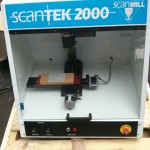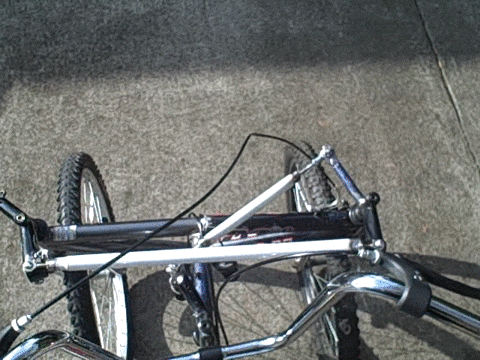I decided that a full set of 3 bearings at 120 degree intervals would take too much alignment and precision so I fell back to the tried and true home-brew DIY pipe and bearing system that uses 90 degree angle iron with skate bearings bolted to it. I used steel angle iron that is 1/8 inch thick and 3/4 inches wide. It cost me $11.23 for a four foot length at my local (over-priced) hardware store. I also purchased eight 1/4 inch bolts, nuts, and nylon lock nuts to hold my bearings for $8.48. (If you purchased bulk boxes the hardware cost would be much cheaper!)
Note that skate bearings have an interior diameter of 8mm which is very close to a 5/16 bolt, but I’m using 1/4 inch bolts and a plastic spacer that I got from disassembling a pair of in-line skates. I had to use a rotary tool with a cutting disk to shorten the plastic spacers to make the nuts clamp down onto the bearings. If you do not have a ready supply of plastic spacers, simply buy 5/16 bolts instead, and wrap the bolt with a turn of plastic tape to get them all the way up to 8mm. With my 1/4 inch bolts, I drilled the holes centered between 5/16 and 3/8 of an inch from the outside edge of the 3/4inch angle iron.
I cut the back plate, pipe supports, cart, and bearing supports from a single piece of 3/4 inch MDF board purchased from the IKEA as-is room for $1. The back plate is 11 inches wide by 12inches high. (The black pipes are 12 inches long.) At the top and bottom of the back plate I have cut out 3 inch tall (by 11 inches wide) pieces of MDF that will support my two black pipes. The pipes have about 1 inch of thread on each end, leaving 10 to 10.5 inches of usable travel space. I want the cart to have at least five inches of travel, so I made it and the angle-iron bearing holders 5 inches long. I also cut out two 5 inch by 2 inch pieces of MDF that mount to the back of the cart to support the bearings. When cutting (imprcisely) with my jig-saw, I made sure that I used factory edges of the MDF when butting pieces together, so that my badly tilting jigsawed edges would not throw my 90 degree angles out of alignment.
Here you can see a video of the pipe in motion being supported by the bearings on the z-axis cart:






